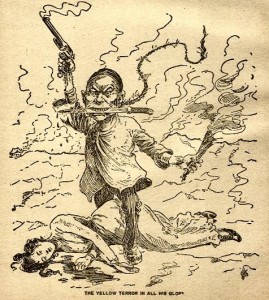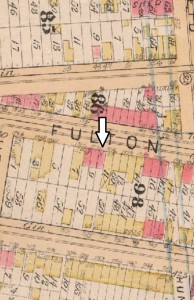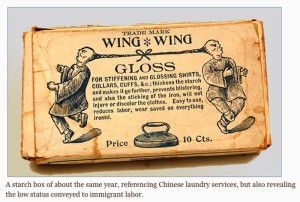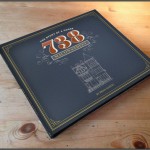In 1886, the life that Wong Sing Bow had been building up for years began to crumble before his eyes.
A naturalized U.S. citizen, Wong Sing had been born “a subject of the emperor of China.” But he had been in America “long enough to save considerable money and to appreciate the beauty of Irish girls,” said one paper of the time. Wong Sing spoke English fluently and was often called upon by the authorities to interpret.
With all that Wong Sing had going for him, it had originally seemed likely that he was going to have a good life. But this was the 1800s.
And Wong Sing was Chinese.
ANTI-CHINESE PREJUDICE IN 19TH CENTURY BROOKLYN
After Wong Sing’s arrival in the U.S. around 1870, according to one paper, “the celestial youth immediately fitted himself in the groove of circumstances.

Apparently, the papers, like most Americans, had no politically correct bent in those days. But the Chinese were located squarely at the bottom of the social construct – just slightly beneath the Irish and the Germans – and so a story like this was great fun for readers of the day. Prejudicial terms were freely used and readers were given the opportunity to view the lives of these people from a privileged vantage point, looking down.
And most essentially, Wong Sing perfectly fit the stereotypes of the day. He was just different enough, though, to stand out and cause a sensation in peoples’ little worlds.
Wong Sing liked “white women.”
WONG SING BOW MEETS MINNIE
In 1877, while working in the laundry business in New Jersey, Wong Sing met Minnie. She had been working as a laundry maid in Paterson, and the two took an evident liking for one another. According to one paper, the two “polished shirt bosoms” and “exchanged tender sentiments which led up to their marriage” the following year.


(Wong Sing, one newspaper reported, appreciated the “beauty of Irish girls,” a line which was meant to suggest the type of girl he would eventually covet for himself; the line would also cement a certain disdain for Wong Sing in the minds of the newspaper’s readers. In some papers, Minnie was Irish, where her maiden name was Geary, while in others, she was German, where she had been born Knester. So disregard, for the moment, her ancestry. The papers of the time were not terribly accurate, either. They were telling pointed stories to targeted audiences – not necessarily truths.)
And so, desperately in love, Wong Sing invested his savings in a laundry which he purchased in the name of his wife. And after a son, George, was born to the couple, they moved to Brooklyn where they operated a laundry at 254 Ewen Street in Williamsburgh, conducting it under the name “Charley Sing,” which, according to Wong Sing (or, more likely, the newspaper reporter writing the story), was more musical than his given name.
Soon thereafter, at 1,772 Fulton Street, where the young family lived, the bottom began to slowly fall out.
POPP THE PEDDLER PEDDLES INTO THE PICTURE
A few years after the marriage, according to Minnie’s later statements in court, Wong Sing began to “pass his time in an opium den on Pearl Street” where he “associated with depraved females of all nations and violated his marriage vows,” eventually meeting a woman named Belle Lee.
This did not sit well with Minnie, who “thereupon left him.”

In the meantime, Wong Sing “installed Belle Lee and her fifteen year old daughter in his laundry” on Ewen Street. (The papers are strangely quiet on details concerning this woman and so it is possible that she did not even exist – along with her child which, it was slyly winked at, may have been Wong Sing’s.)
Along (understandably) came the Society for the Prevention of Vice – an institution notorious for its supervision of the public morality – which summarily had Wong Sing arrested for his immoral conduct. Wong Sing was acquitted, though, and he went back to his life as a Chinese laundryman.
THE RETURN OF MINNIE

Shortly after this episode, Minnie returned to the laundry and seemed to have patched things up with Wong Sing. All went well until a German peddler by the name of John Popp came along to sell some patent starch to Charley Sing.
(And here is where the story takes a twist, and the newspapers, much to the satisfaction of their readerships, really stick it to the Chinese Melican.)
Minnie took the opportunity at that time to give Wong Sing some of his own medicine, eventually eloping with her social equal, whereupon the couple “went to New Jersey where she obtained a divorce by default.” There she married Popp the peddler, of 1,236 Myrtle.

Shortly thereafter, Popp, according to Wong Sing, “who had been in the habit of visiting at my house, had driven up with a large truck shortly after I left” one day.
Popp allegedly “carted away” his property – at a value of $300 worth of furniture. It was assumed by Wong Sing that the truck was driven to 1,236 Myrtle Avenue, where the newly bound couple planned to live a life of love and harmony with Wong Sing Bow’s chairs.
WHAT HAPPENED TO MINNIE?

The papers are mum on how all of this ended. It is likely that the journalists lost interest as the case wound its way through the court system.
Evidence exists, though, to show that John and Minnie Popp were still together years later, living at 70 Utica Avenue in Stuyvesant Heights, with their three children, William, John, and – George B.
Was it possible that the “George B.” of the 1900 Federal Census was actually the only child of Wong Sing and Minnie? Four indicators show that this is highly likely:
1) In later census documents, Wong Sing is not living with his son, George.
2) As the eldest son, George B.’s birthday squarely fits the time Wong Sing’s son was born.
3) George’s birthplace is listed as New Jersey.
4) And lastly, but most important, on George B.’s line in the census, before the “W” for “white” and right after the word “son,” you can just barely make out a single word in parentheses: “adopt.”
WHAT HAPPENED TO WONG SING?

Five years later after Minnie and Wong Sing separated, Wong Sing, going by “Sing Bow,” and another man by the name of Lang Bow were living together in Williamsburgh, Brooklyn. According to the 1892 Census, they were both working in the laundry business.

Two years after this census was taken, Wong Sing was in the papers again, marooned in Havana without a passport, and asking for help from the U.S. government.
The story noted that he was living in New Jersey by this time, but that the Spanish Consul refused to allow him aboard a steamer until he could produce a passport.
The “Chinese Inspector,” it was noted, though, was going to help him out.
And so, with the trials and tribulations of Wong Sing solved, he melted slowly but permanently into the miasma of Brooklyn history…
———————————————————————————————————————–
 The story you just read was composed from historical research performed by The Brownstone Detectives. Allow us do an in-depth investigation of your house and its former owners and produce your very own House History Book. Your hardbound coffee table book will include an illustrated and colorful narrative timeline that will bring the history of your house to life. Contact us today.
The story you just read was composed from historical research performed by The Brownstone Detectives. Allow us do an in-depth investigation of your house and its former owners and produce your very own House History Book. Your hardbound coffee table book will include an illustrated and colorful narrative timeline that will bring the history of your house to life. Contact us today.

















